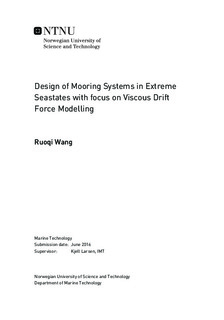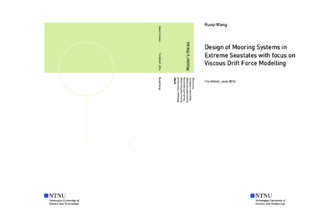| dc.description.abstract | Recent years floating structure are widely used for different marine operations. So increases the usage of mooring system rapidly to perform its position-keeping function. However, high failure rate of mooring system catches people's attention. The overloaded mooring lines in operation uncovers the hidden danger in insufficient prediction of low-frequency excitation and damping force. Based on previous theoretical analysis and model tests, the failure is mainly due to the ignorance of viscous effect on the structure. Therefore this thesis mainly focuses on viscous drift force modelling on a semi-submersible under extreme weather condition.
Important theory were developed first. Three viscous models were established with their expressions derived. Then the Frequency Domain method and Time Domain method were explained and compared. They had different ways to deal with a given signal with their own advantages and shortcomings. Different software were applied accordingly. For calculating the tension in mooring line, quasi-static method and dynamic method were explained and compared.
Floatel Superior was modeled with 12 mooring lines evenly spread in shallow water with 150m depth. The mooring lines consisted of chain and fibre. The structure was researched under 100-year return period weather condition. Since it had been researched in Frequency Domain by MIMOSA in Autumn 2015, in order to keep the model with same characteristic and vessel file as before, the SIMO input file was verified with the MIMOSA file before doing further analysis.
Force coefficients, transfer functions, restoring force, decay test and structural response under one specific case were compared one by one. Only the linear damping value in SIMO file was modified. All results showed that SIMO file was consistent with MIMOSA file, only with a relative lower damping value.
In order to take viscous effect into account, two different methods were applied: slender element method and correction formula method. They had different strategy to account for viscous force. Based on the increase in tension and motion, it was concluded that viscous effect was really important in structure response analysis. Ignoring viscous effect will certainly induce an underestimation of LF excitation force and damping force, then further provide a conservative estimation in mooring line tension and structure motion.
Both methods were effective, while slender elements brought a more accurate and reliable result and correction formula was doubted. Extra damping modification were applied to improve the correction formula method. It worked but not so realistic in real practice.
A sensitivity test was performed to know how the variation in drag coefficient affect the response. The 'tuning' equation was applied to tune the drag coefficient on column and pontoon. Two parallel comparison group were created. The smaller coefficient would induce a smaller drag force on structure.
In order to figure out the relative importance of different loads, the model was researched under single environment load separately. According to the response result, wave was dominating among all three loads, and it had interaction with current when they existed at the same time. Wind gave largest effect in static analysis, due to its large velocity and large exposure ares of structure.
The most-loaded line was selected and modeled in RIFLEX. The 3-hour motion series from SIMO was imported as input and the corresponding tension result was used to compare with the SIMO result. The motion series was verified to be consistent through the export and import among software. From the plot, tension result from RIFLEX and SIMO had almost overlapped with each other, which means they were consistent. Only in Wave Frequency band, the RIFLEX result had larger standard deviation value, and had a larger crest and trough in the figure. Due to RIFLEX used the Finite Element Method and dynamic method to calculate the tension, it had a higher tension result. Therefore it gave an amplification effect to the SIMO result. The Dynamic Amplification Factor was calculated as well. | |

